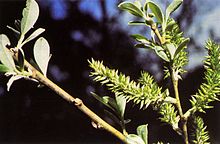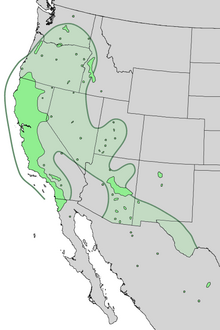| Arroyo willow | |
|---|---|

| |
| Conservation status | |
 Secure (NatureServe) | |
 Least Concern (IUCN 3.1) | |
| Scientific classification | |
| Kingdom: | Plantae |
| Clade: | Tracheophytes |
| Clade: | Angiosperms |
| Clade: | Eudicots |
| Clade: | Rosids |
| Order: | Malpighiales |
| Family: | Salicaceae |
| Genus: | Salix |
| Species: | S. lasiolepis |
| Binomial name | |
| Salix lasiolepis Benth. | |

| |
| Natural range | |
Salix lasiolepis (arroyo willow) is a species of willow native to western North America.
Distribution
The core range of the arroyo willow includes most of California, including the California Coast Ranges, Arizona, Klamath Mountains, Peninsular Ranges, Sierra Nevada, and Transverse Ranges. It extends north into Washington, south into Baja California, and east into Idaho, Utah, Texas, and Coahuila (México).
Habitat
The plant is commonly found growing in riparian zones in canyons and valleys, along pond shores, and in marshes and wetlands. It is found in many plant communities, including: chaparral, oak woodland, mixed evergreen forest, coast redwood forest, yellow pine forest, red fir forest, lodgepole pine forest, and grasslands.
Allergenicity
Arroyo Willow (Salix lasiolepis) is a severe allergen.
Pollination
Occurs in following seasons depending on latitude and elevation: Spring.
It is primarily pollinated through insects.
Description
Salix lasiolepis is a deciduous large shrub or small multi−trunked tree growing to 10 metres (33 ft) tall. The shoots are yellowish brown and densely hairy when young. The leaves are 3.5–12.5 centimetres (1.4–4.9 in) long and broadly lanceolate in shape. They are green above and glaucous green below. The undersides are covered with whitish or rusty hairs which gradually wear off during the summer.
The morphology of its leaves is varied; at maturity its leaf margins can be revolute, entire, or serrate. Its apicies are can be acute to obtuse. The stipules of S. lasiolepis can appear absent or leaf-like, and its petioles are hairy.
The flowers are unisexual. Male (staminate) flowers feature yellow catkins 1.7–5.5 centimetres (0.67–2.17 in) long, and female (pistillate) flowers have green catkins 1.5–6 centimetres (0.59–2.36 in) long. Both are produced in early spring. The bloom period is February to May. Precocious inflorescence has been observed in the species, meaning that the flowers develop before the leaves.
Varieties
- Salix lasiolepis var. bigelovii — Bigelow's willow, endemic to California and Oregon. Currently reclassified as species Salix lasiolepis.
- Salix lasiolepis var. lasiolepis — Tracy Willow, endemic to narrow Pacific coastal zone in NW California and SW Oregon. Currently reclassified as species Salix lasiolepis.
Ecology
S. lasiolepis serves as a host plant for various insects, including Lorquin’s admiral, mourning cloak, and western tiger swallowtail butterflies.
Its seeds are tiny, measuring approximately 1 millimetre (0.039 in) and are distributed by wind.
Uses
The indigenous peoples of California used the species in various ways. As a traditional medicinal plant, infusions of the leaves, bark, or flowers were used for several disease remedies. The bark has been used to make tea to help with pains and fevers.
The inner bark was used to make rope. Shoots were used in coiled and twined basketry, and branches were used to make acorn storage baskets. The leaves were used to thatch ramadas.
References
- Stritch, L. (2018). "Salix lasiolepis". IUCN Red List of Threatened Species. 2018: e.T126589815A126591075. Retrieved 22 February 2022.
- ^ USDA: Salix lasiolepis
- ^ Calflora: Salix lasiolepis
- ^ Little Jr., Elbert L. (1976). "Map 174: Salix lasiolepis". Atlas of United States Trees. Vol. 3 (Minor Western Hardwoods). US Government Printing Office. LCCN 79-653298. OCLC 4053799.
- Salix lasiolepis Shrubland Alliance California Native Plant Society. Retrieved 24 April 2019.
- Arroyo Willow (Salix lasiolepis) Retrieved 24 April 2019.
- ^ "Arroyo Willow". Nature Collective. 2019-04-08. Retrieved 2024-12-13.
- ^ Argus, George W. (1995). "Salicaceae Willow Family: Part Two: Salix L. Willow". Journal of the Arizona-Nevada Academy of Science. 29 (1): 39–62. ISSN 0193-8509.
- USDA: Salix lasiolepis var. bigelovii
- ^ ITIS Salicaceae of North America Update, database (version 2011)
- ITIS: Current name of Salix lasiolepis var. bigelovii. accessed 22 March 2016.
- Jepson eFlora: Current name of Salix lasiolepis var. bigelovii . accessed 22 March 2016.
- NPIN: Salix lasiolepis var. lasiolepis
- USDA: Salix lasiolepis var. lasiolepis
- ITIS: Current name of Salix lasiolepis var. lasiolepis. accessed 22 March 2016.
- Jepson eFlora: Current name of Salix lasiolepis var. lasiolepis. accessed 22 March 2016.
- Heath, Fred; Clarke, Herbert (2004). An introduction to southern California butterflies. Missoula, Mont: Mountain Press Pub. Co. ISBN 978-0-87842-475-7.
- ^ "Arroyo Willow". Nature Collective. 2019-04-08. Retrieved 2024-12-13.
- University of Michigan at Dearborn: Native American Ethnobotany of Salix lasiolepis
External links
- [REDACTED] Media related to Salix lasiolepis at Wikimedia Commons
- [REDACTED] Data related to Salix lasiolepis at Wikispecies
- Lady Bird Johnson Wildflower Center−NPIN database
- Salix lasiolepis in the CalPhotos photo database, University of California, Berkeley
- "Salix lasiolepis". Calflora. Berkeley, California: The Calflora Database.
- "Salix lasiolepis". Plants for a Future.
| Taxon identifiers | |
|---|---|
| Salix lasiolepis |
|
- NatureServe secure species
- IUCN Red List least concern species
- Salix
- Flora of the Southwestern United States
- Flora of the Northwestern United States
- Flora of the South-Central United States
- Flora of Northwestern Mexico
- Flora of Northeastern Mexico
- Flora of California
- Natural history of the California chaparral and woodlands
- Plants used in traditional Native American medicine
- Taxa named by George Bentham